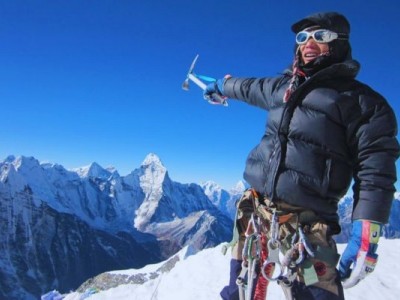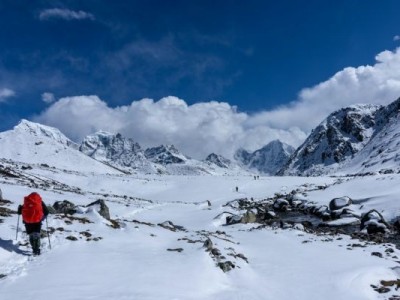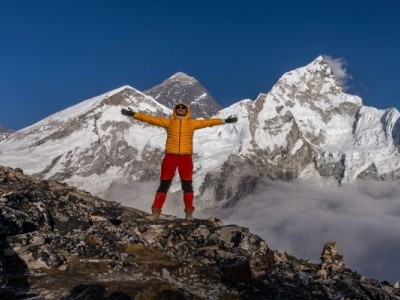Overview of Upper Dolpo Trek
Upper Dolpo is one of the least polluted and least culturally modified regions of Nepal, located in the remote Trans-Himalayan area of northwestern Nepal. The area is a restricted trekking area and offers a truly unique glimpse into Tibetan Buddhist culture, completely unaltered for centuries.
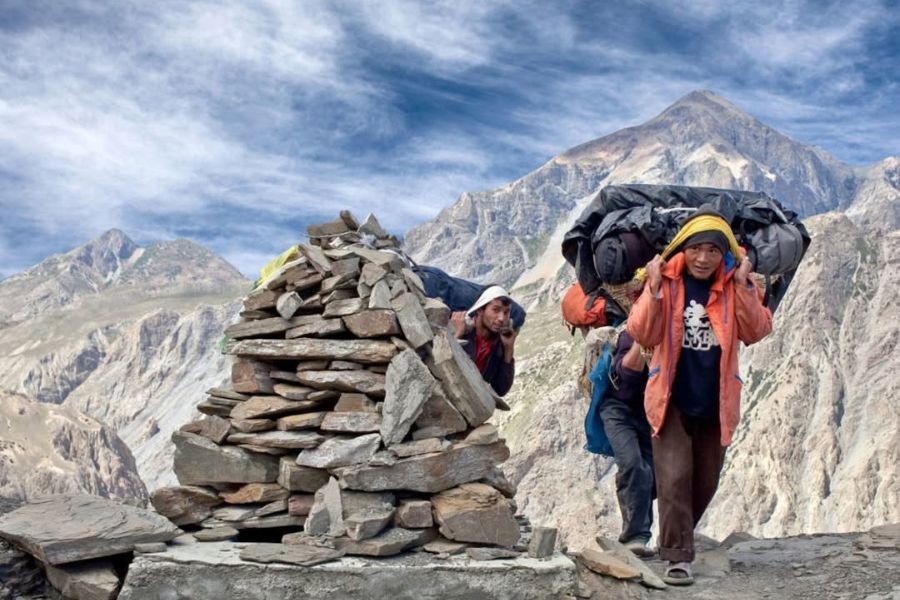
Location and Cultural Significance
Upper Dolpo is located in the rain shadow of the Himalayas, providing a high-altitude desert-type landscape with ancient, traditional villages. It is home to beautiful gompas or monasteries, historical trade routes, and communities still practicing traditional Bon Buddhism in addition to Tibetan Buddhism. Trekkers will explore authentic Tibetan culture, ancient caravan trails, and unbelievably beautiful terraced barley fields carved into the mountainsides.
The Reasons for the Restricted Trekking Designation for Upper Dolpo
Upper Dolpo was designated as a restricted area by the Nepalese government to protect the delicate ecosystems and fragile cultural resources of the region. This area was made protected for the ultimate benefit of the cultural integrity of the communities - preventing future forced alteration to their traditional ways of life, ways of being in the world, and social life. Additionally, this restriction helps to reduce the overwhelming effects of mass tourism on local communities, allows for sustainable tourism principles, and assists in ensuring the preservation of their culture and environment.
Adventure Appeal for Remote Trail Seekers
Upper Dolpo is known for attracting adventurous trekkers in search of genuine wilderness experiences with fewer crowds. It features famous high passes, stunning alpine lakes, and the opportunity to see rare wildlife, including snow leopards and blue sheep. The remoteness of the area allows for some of the best solitude available to travelers and spiritual experiences in what is considered one of the last hidden valleys on earth.
Upper Dolpo Trek Itineraries (Our Packages)
These all are our avilable package's itinerary of the Dolpo region trek, If you are intrested to do Upper dolpo trek than you simply need to contact us and we can organize your Dolpo adventure according to your choice and preferance. (These itineraries are customizable)
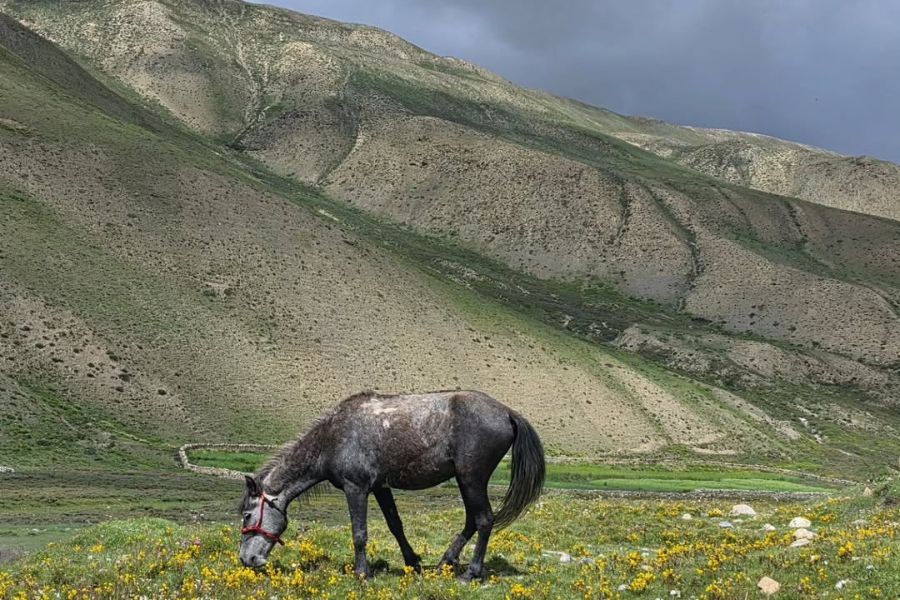
Upper Dolpo Trek - 21 Days
Detailed day-by-day Itinerary for your Upper Dolpo Trek:
DAY 1: Kathmandu to Nepalgunj. Take a morning flight from Kathmandu to Nepalgunj that takes about 1 hour and 15 minutes. You will then spend the rest of the day in Nepalgunj and use that time to prepare for your early morning mountain flight to Juphal tomorrow. Today is a rest day, a chance to organize any final trek preparations, and an opportunity for you to acclimatize to the different temperatures. Altitude: 150m | Accommodation: Hotel
DAY 2: Nepalgunj to Juphal to Dunai Take a scenic flight in the early morning (about 30 minutes) to Juphal, from there you will begin your trek to Dunai via Sulighat, with views of terraced fields and small settlements along the way. The trek gives you beautiful views of the surrounding hills and a taste of rural Dolpo culture. Distance: 3-4 hours | Altitude: 2,140m | Accommodation: Lodge
DAY 3: Dunai to Chhepka Trek along the Thuli Bheri river passing through beautiful pine and juniper forests, and arriving at Roop Ghar village. From there, trek across various suspension bridges over rushing mountain streams. The trail is a gentle ascent and will take you deeper into the Dolpo wilderness with mountain views increasing in splendour. Distance: 5-6 hours | Altitude: 2,838m | Accommodation: Lodge
Day 4: Chhepka to Jharana Hotel Cross through Ryajik village, and continue upstream through the river valley. Trek through a beautiful gorge with several stunning waterfalls cascading down from the cliffs. After passing through all of the gorge's beauty, we gain elevation and wind our way toward the upper valleys, surrounded by some beautiful peaks. Distance: 6-7 hours | Altitude: 3,130m | Accommodation: Lodge
Day 5: Jharana Hotel to Phoksundo Lake. We make our final approach to beautiful Phoksundo Lake, Nepal's deepest lake. After passing through Palam village, we arrive at Ringmo village and catch our first glimpse of the turquoise waters of Phoksundo Lake. We're about to enter the heart of Dolpo as we transition to the breathtaking, refreshing landscape. Distance: 4-5 hours | Altitude: 3,611m | Accommodation: Lodge
Day 6: Rest Day at Phoksundo Lake. You will have a full day to enjoy Ringmo village and the local Dolpo-pa people. You can hike to the ancient Tashung Gompa monastery. A full acclimatization day will give you and your travel group some time for fantastic photography around the turquoise waters. You can hike around the lake's perimeter. Altitude: 3,611m | Accommodation: Lodge
Day 7 - Phoksundo Lake to Phoksundo Khola. You have begun your trek to Upper Dolpo, and now follow the Phoksundo River upstream. The gorge begins to narrow until you may be crossing the river numerous times as you ascend, which will be exhausting but also thrilling. Now off the main trek of Upper Dolpo, the trail takes some rugged paths and you finally camp in true wilderness beside the thundering river - your first evening under canvas in Upper Dolpo! Driving Distance: 6-7 hours | Altitude: 3,507m | Accommodation: camping
Day 8 - Phoksundo Khola to Phoksundo Bhanjyang. Get up and make a steep ascent (very steep) through the increasingly rocky landscape (but not yet at the top). We had a lot of stream crossings, and some areas where ancient glaciers deposited moraine over the valley bottom, and each of these could be rocky and arduous, too. Once we reach a high camp below the high pass, we unpack, rest, and mentally prepare for a big day tomorrow! Driving Distance: 5-6 hours | Altitude: 4,402m | Accommodation: camping
Day 9 - Phoksundo Bhanjyang to Shey Gompa via Kang La Pass. Start early, as tomorrow will be crossing Kang La Pass, 5,360 meters, one of the hardest but most rewarding days of the trek. At this height, you will have spectacular views of the mountains if the weather cooperates, and the experience is rewarding. Once down from the pass, you will descend the valley by Shey Gompa, the spiritual heart of Upper Dolpo. Enjoy ancient monasteries, and your cultural and natural experiences here remain unmatched. Driving Distance: 7-8 hours | Altitude: 4,390m | Accommodation: Lodge
Day 10 - Rest day in Shey Gompa. Today, we'll visit Shey Gompa and its 11th-century monastery, and explore the sacred Crystal Mountain - an important site for local Buddhists. You will likely see local animals on the high pasture, including blue sheep. You'll also get to spend time with the monks who live at Jamie Gompa and learn about their spiritual practices and the history of the monastery. Altitude: 4,390m | Accommodation: Lodge
Day 11 - Trekking from Shey Gompa to Namduna Gaun. You will trek through the high desert landscape characteristic of the high altitude desert of Upper Dolpo as part of the Trans-Himalaya. After several hours of trekking, you will ascend to 5,095 meters over Sela Pass, where you'll be able to take in the stunning panoramic views of the surrounding peaks and valleys. After resting on the pass, you will then descend to Namduna, seeing the landscape change again dramatically before we reach Namduna. Distance: 6-7 hours | Altitude: 4,430m | Accommodation: Lodge
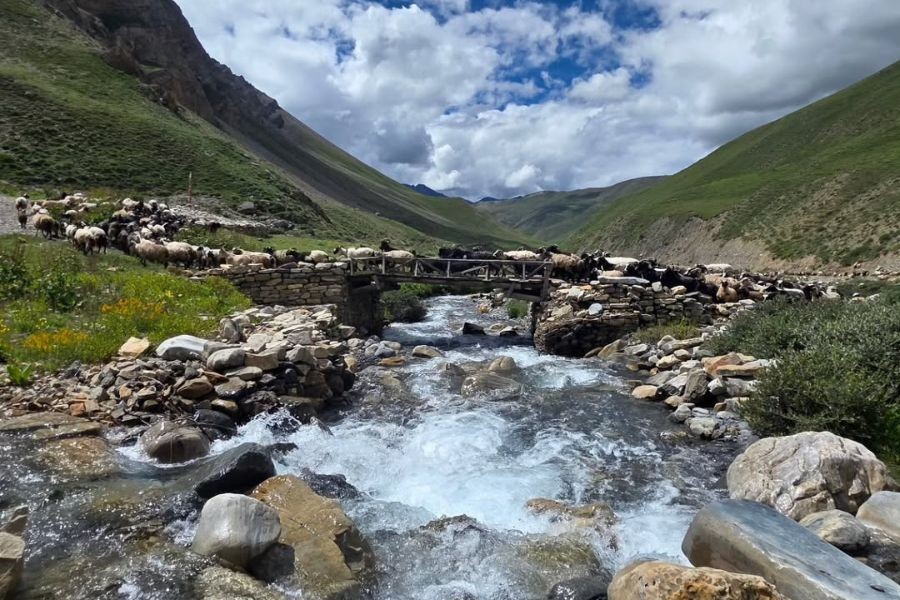
Day 12 - Trekking from Namduna Gaun to Saldang. Today, we will cross high plateau terrain, passing some small Tibetan villages and ancient chortens. You will pass through a few more small settlements before arriving in Saldang. Saldang is the largest village in Upper Dolpo and has a great atmosphere for experiencing authentic Tibetan Buddhist culture and architecture. Distance: 5-6 hours | Altitude: 3,903m | Accommodation: Lodge
Day 13 - Rest Day in Saldang. Immerse yourself in the authentic Tibetan Buddhist culture of this remote village, where life has remained unchanged for centuries. Visit the Buddhist gompa, and meet villagers who follow traditional lifestyles of yak herding and barley farming. Engage with truly authentic Upper Dolpo culture and observe traditional farming techniques that adapt to the high altitude. Altitude: 3,903m | Accommodation: Lodge
Day 14 - Saldang to Yangze Gompa Trek through barren landscapes to one of the oldest monasteries in the area. Stop and visit the Yangze Gompa, built 1,000 years ago, and built on the side of a cliff above the valley. Engage with the monk who calls Yangze Gompa home and learn about life in one of the most remote monasteries in the world. Distance: 4-5 hours | Altitude: 4,960m | Accommodation: Lodge
Day 15 - Yangze Gompa to Sibu Descent through very beautiful valleys with traditional villages with ancient mani walls written with Buddhist prayers. Continuing an ancient trade route that has linked Tibet and Nepal for centuries. The beautiful changing landscapes will give great opportunities for photography, as well as to embrace and understand different cultures. Distance: 6-7 hours | Altitude: 4,115m | Accommodation: Lodge
Day 16 - Sibu to Jeng La Phedi. Prepare yourself for the second major pass crossing on this trek, hiking to base camp below Jeng La Pass. Use the afternoon for final preparations, and retire early to rest for what will be another long and challenging crossing tomorrow. The high camp location provides excellent views of the surrounding peaks and valleys. Distance: 4-5 hours | Altitude: 4,900m | Accommodation: Camping
Day 17 - Jeng La Phedi to Tokyu via Jeng La Pass. We will need to depart early for the crossing of Jeng La Pass at 5,090 meters, taking time to appreciate the dramatic views of the Dhaulagiri range on clear days! Then a long descent down to Tokyu village, and you will notice the landscape starting to change as we enter the Tarap valley system. Distance: 7-8 hours | Altitude: 4,209m | Accommodation: Lodge
Day 18 - Tokyu to Dho Carrying on, you will descend through the beautiful Tarap valley, passing through the changing landscape and vegetation zones as you lose altitude. This valley will provide an unexpected contrast to Upper Dolpo's barren plateaus, featuring terraced fields and more green surroundings, and we will arrive in Dho with its beautiful terraced barley fields. Distance: 5-6 hours | Altitude: 3,944m | Accommodation: Lodge
Day 19 - Dho to Tarakot Descend into the Tarap Khola valley over the route of the ancient trade route that winds through many small settlements. As you descend into lower altitude, you will pass through lower valleys with generally mind-blowing topography and vegetation, each descent seeming to bring yet more beauty. You will arrive in the historic village of Tarakot, which once served as a trading post between Nepal and Tibet. Distance: 7-8 hours | Altitude: 2,537m | Accommodation: Lodge
Day 20 - Tarakot to Juphal. On your last day of trekking, you will traverse lower valleys with gentler terrain and warmer temperatures. Riding the Bheri River downstream through terraced fields and tiny hamlets. You will celebrate the end of your incredible Upper Dolpo circuit with your team and fellow trekkers. Distance: 6-7 hours | Altitude: 2,475m | Accommodation: Lodge
Day 21 - Juphal to Nepalgunj to Kathmandu. Fly from Juphal to Nepalgunj in the morning and then connect on an afternoon flight to Kathmandu. You will be transferred back to your hotel to rest after over a week of trekking in the mountains. It will be time to enjoy a celebratory dinner acknowledging the completion of your Upper Dolpo adventure. You will have plenty of chances to reflect on the magnificent landscapes and iconic regional culture you experienced on this trek and the personal achievements you have made.
Note: Here you can go through our classic Upper Dolpo trek and you can see an itinerary that covers the complete circuit, including Shey Phoksundo National Park's major highlights. It provides ample time for acclimatization and cultural immersion, making it ideal for trekkers seeking the full Dolpo experience.
Jumla to Phoksundo Lake Trek - 11 Days
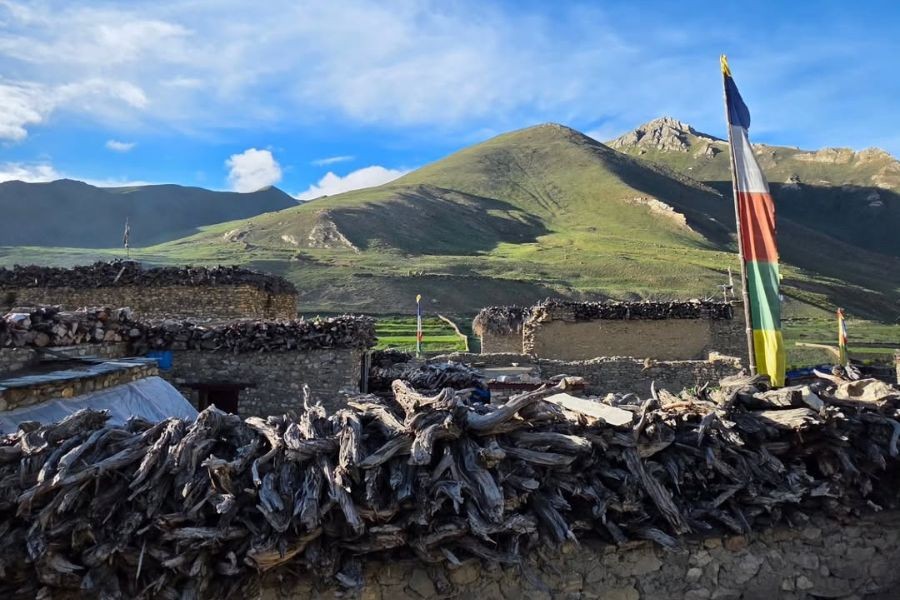
Day 1-2: Fly to Jumla, explore the town, and begin trekking toward Chere Chaur.
Day 3-4: Trek through Chautha and cross Kagmara La Pass (5,115m).
Day 5-7: Descend to Phoksundo Lake via the Phoksundo River Valley.
Day 8-9: Explore the Ringmo village and its surroundings, including Phoksundo Lake.
Day 10-11: Trek to Juphal before flying back to Nepalgunj and then Kathmandu.
Note: This shorter Jumla to Phoksundo Lake trek that requires a restricted area permit is tailored towards arriving at the stunning Phoksundo Lake from the historical trade town of Jumla. It is an ideal trip for those with limited time or for trekkers only interested in seeing some of Dolpo's natural wonders.
Phoksundo Lake Trek - 9 Days
Day 1-2: Fly to Juphal via Nepalgunj and trek to Dunai.
Day 3-4: Trek through Chhepka to the Jharana Hotel area.
Day 5-6: Arrive at Phoksundo Lake, then explore Ringmo village and Tashung Gompa.
Day 7-8: Rest day at the lake, photography, and return trek begins.
Day 9: Trek to Juphal then fly back to Kathmandu.
Note: The Phoksundo lake trek, this itinerary focuses entirely on the stunning turquoise Phoksundo Lake and nearby Ringmo village, offering spectacular scenery with moderate difficulty.
Lower Dolpo Circuit Trek - 16 Days
Day 1-3: Arrive in Juphal, then trek through Dunai to Tarakot.
Day 4-6: Continue to Dho and cross Numa La Pass (5,360m).
Day 7-9: Visit Phoksundo Lake, explore the surrounding areas.
Day 10-12: Cross Baga La Pass and explore Dho Tarap valley.
Day 13-16: Return via a different route through Tarakot and back to Juphal.
Note: This moderate Lower Dolpo circuit trek combines with easier access to Phoksundo Lake. It offers diverse landscapes and cultural experiences without requiring the full Upper Dolpo permit.
Dolpo to Jomsom Trek - 27 Days
Day 1-5: Complete Phoksundo Lake approach and exploration.
Day 6-12: Travel through Upper Dolpo via Shey Gompa and high passes.
Day 13-18: Cross challenging passes toward the Mustang region.
Day 19-22: Explore Upper Mustang villages and culture.
Day 23-27: Descend through Charang, Lo Manthang, and reach Jomsom.
Note: This challenging Dolpo to Jomsom Trek expedition connects two of Nepal's most restricted regions. It requires excellent physical fitness and experience with high-altitude trekking, offering the ultimate Trans-Himalayan adventure.
Upper Dolpo Trek Permits
Required Permits for Upper Dolpo
Upper Dolpo trekking needs permits:
Restricted Area Permit (RAP): This is an access permit to the restricted Upper Dolpo area. The RAP indicates exact dates, route, and group members, and there is no option to change your RAP after you have received it.
Shey Phoksundo National Park Entry Permit: This permit is required because it is an entry permit to enter Nepal's largest national park, which incorporates most of the Upper Dolpo trekking area into the park. This also supports the maintenance and conservation of the National Park.
Upper Dolpo Permit Costs
Restricted Area Permit:
- First 10 days: USD 500 per person
- Additional days cost USD 50 per person.
Shey Phoksundo National Park Permit:
- Foreign nationals: NPR 3,000 per person
- SAARC nationals: NPR 1,500 per person
Additional Costs:
- Guide fees: USD 25-35 per day
- Porter fees: USD 15-20 per day
- Trekking agency service charges vary
Solo trekkers cannot obtain permits independently; all permits must be arranged through licensed trekking agencies with mandatory guide services.
How to Get Upper Dolpo Trek Permits
Application Process:
- Contact a licensed trekking agency in Kathmandu
- Provide passport copies and a detailed itinerary
- Apply at least 2 weeks before departure
- Pay permit fees and agency charges
- Receive permits 1-2 days before trek departure
Required Documents:
- Valid passport with 6+ months validity
- Passport-sized photographs
- Travel insurance details
- Detailed trek itinerary
- Emergency contact information
Processing Location: All Upper Dolpo permit cost processing occurs in Kathmandu through authorized agencies. Permits cannot be obtained in Dolpo or other regions.
Important Permit Rules & Regulations
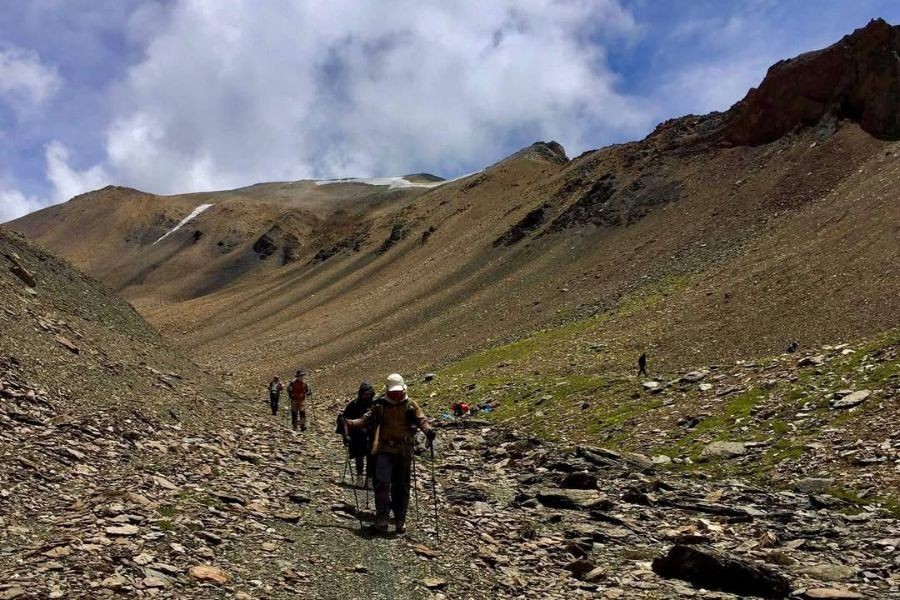
Minimum Group Size Requirements
Upper Dolpo treks have a minimum of 2 trekkers per group, so it is not possible to trek there solo. This is for safety in remote areas, as well as to provide local guides with employment.
Licensed Guide Needed
A licensed guide provided by a trekking agency must accompany each Upper Dolpo trek for its entire duration. This is useful for cultural interpretation, to guide you on the safest route, and to help you keep in compliance with your permit.
Licensed Agencies are Required to Process Permits
Individually submitting permit applications is not permitted. All permits must be processed by licensed trekking agencies. All the logistics, permits, plans, and arrangements must be done through a licensed agency to ensure compliance with regulations.
Practical Tips for Itinerary & Permit Planning
Best Time to Trek Upper Dolpo
Optimal Seasons:
- May to October: Clear weather, accessible passes, and comfortable temperatures
- September-October: Best visibility, stable weather, and harvest season festivities
- May-June: Blooming wildflowers and fewer crowds
Avoid Winter Months: November to April is extreme cold, blocked passes, and limited accommodations.
Physical Requirements and Altitude Considerations.
Upper Dolpo can exceed altitudes of 5,000 meters, and thus an extremely good fitness level and acclimatization to altitude are required. Begin cardiovascular training 3-4 months before departure, as well as walks with a weighted pack.
Altitude Considerations:
- Acclimatization days are mandatory in itineraries
- Carry altitude sickness medication
- Recognize symptoms of altitude-related illnesses
- Maintain proper hydration and nutrition
Choosing the Right Trekking Agency
Select agencies with:
- Valid government licenses for restricted area treks
- Experienced Upper Dolpo guides
- Comprehensive insurance coverage
- Positive reviews and recommendations
- Transparent pricing structures
- Emergency evacuation procedures
Budgeting for Permits, Guides, and Logistics
Total Budget Range: USD 3,000-5,000 per person for complete Upper Dolpo treks
Budget Breakdown:
- Permits and fees: 15-20%
- Guide and porter costs: 25-30%
- Accommodation and meals: 20-25%
- Transportation: 15-20%
- Equipment and miscellaneous: 15-20%
FAQs
How far in advance should I apply for Upper Dolpo permits?
At least 2-3 weeks before your planned start date is optimal to allow time for processing.
Can I change my Upper Dolpo trek itinerary after obtaining permits?
No, the RAP permits only allow for specific dates and routes, and you are not allowed to make any changes after it is issued.
What if my permitted date allows for bad weather delays?
Your trekking agency can assist you in applying for an extension, but it is not guaranteed, and there will be costs attached to it.
Are there accommodation facilities in Upper Dolpo?
Basic accommodation on Upper Dolpo trek will be available in the main villages, but it may be necessary to camp in remote areas.
What fitness level do I need to be for the Upper Dolpo trek?
Due to high altitude, long daily trekking distances, and tough underfoot conditions, you will require a very high level of physical fitness.
Conclusion
The process of planning an Upper Dolpo Trek itinerary & permits allows access to one of Nepal's greatest wilderness experiences. This guide outlines the vital information to navigate permits, select itineraries, and prepare for your Upper Dolpo experience.
Are you ready to start your Upper Dolpo adventure?
Contact us today at Himalayan Ecological Trekking for your Upper Dolpo trek permits, itinerary planning advice, or professional guiding service. Our experienced team will help you process your permits with ease and have a remarkable experience in Dolpo.
Inquire Now: [email protected]
Expert Consultation: WhatsApp: +977 9851006023 (Bikesh)
.jpg)





